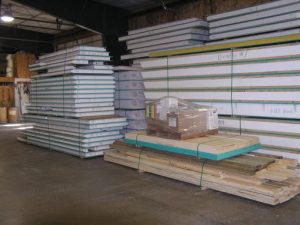SIP Panels and R-Values: What They Mean and Why They Matter
When you hear the word “insulation,” do visions of cotton candy looking fiberglass dance in your head? Fortunately, advances in technology mean you don’t have to rely on this itchy, pink nightmare. Instead, continuous insulation products like structural insulated panels (SIPs) are here to provide a more energy efficient building envelope.
As discussed in last month’s blog, SIPs are a high-performance building system alternative. One of the reasons SIPs are so effective is that they deliver high R-values. R-value is a measure of how well insulation resists the flow of heat or cold. The higher the R-value, the better the product’s ability to serve as an effective thermal barrier. But, how exactly are SIPs able to achieve such high ratings?
SIP Panels’ Rigid Foam Insulation + OSB = superior insulating power
 Let’s start with a visual of the SIP sandwich. With the SIPs’ expanded polystyrene rigid foam core, or the “filling,” the insulation consists of 98% air. Since there are few other chemicals in the insulation, R-values remain consistent and unchanging over time. SIPs’ R-values can vary depending on the type of core material used, and we at Extreme Panel Technologies are partial to expanded polystyrene for its stable numbers throughout its time in service.
Let’s start with a visual of the SIP sandwich. With the SIPs’ expanded polystyrene rigid foam core, or the “filling,” the insulation consists of 98% air. Since there are few other chemicals in the insulation, R-values remain consistent and unchanging over time. SIPs’ R-values can vary depending on the type of core material used, and we at Extreme Panel Technologies are partial to expanded polystyrene for its stable numbers throughout its time in service.
Now, let’s move outward to the SIPs’ “bread” – oriented strand board (OSB). With SIPs, OSBs completely envelop the insulating core. Since the two materials are laminated together, gaps found in buildings with traditional studs are eliminated. In fact, SIPs can be 15 times tighter than conventional construction, which is vulnerable to air infiltration.
OSB further offers a higher insulating value when compared with metal or dimensional lumber studs’ R-values. This means that OSB can help provide a higher R-value for the entire wall surface, known as whole-wall R-value (an R-value estimation for insulation, structural details, and building envelope interface elements). SIPs thickness can additionally contribute to overall R-values.
It’s also worth noting how SIPs perform better than loose-fill fiberglass insulation. As the Structural Insulated Panel Association (SIPA) shares, studies by Oak Ridge National Laboratories (ORNL) of attic insulation reveal that the rigid foam insulation used in SIPs “actually performs better in colder temperatures. Expanded polystyrene with a stated R-value of R 3.9 per inch at 75°F was tested at R-4.2 at per inch at 50°F and R-4.4 per inch at 25°F.” This was not the case with fiberglass in attics. As ORNL found, as outside temperatures dropped, so too did fiberglass’ R-values decrease.
Why R-values truly matter when it comes to SIP panels
While we’ve proved that SIPs offer superior insulating power, what does that mean for your residential and commercial projects? For starters, builders and architects can save time, labor and money. As outlined in our SIPs Frequently Asked Questions, whole-wall R-value means building teams can downsize HVAC equipment, minimize ductwork and reduce temporary heat during construction.
What’s more, clients will thank you. With some SIPs’ R-values guaranteed for 20 years, that’s 20 years of lower heating and cooling bills. This is especially important when one considers how heating and cooling account for the largest expense for most homes, according to the US Department of Energy.
Superior insulation means superior energy efficiency, and homeowners who incorporate SIPs can possibly qualify for Energy Efficient Mortgages. Both homeowners and commercial building owners may also be eligible for federal income tax credits and additional incentives for energy efficiency through Energy Star.
But don’t take our word for it. See what our SIP customers are saying here.


